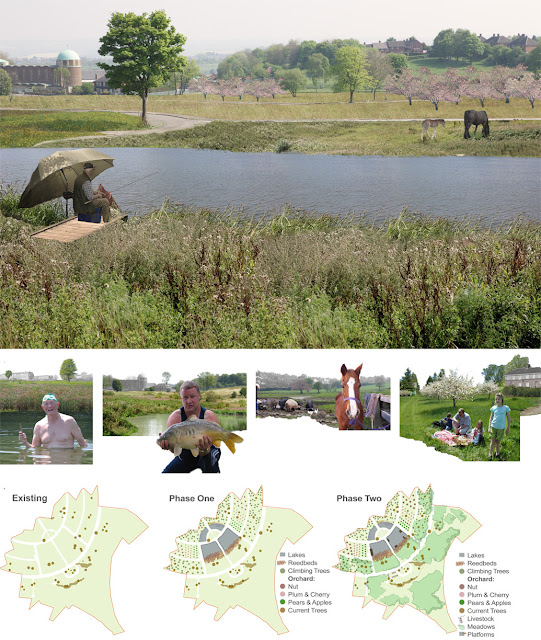Competition entry – Sheffield's Forgotten Spaces 2011, RIBA Yorkshire
Team – Bob Levene (Artist) Neus Vilalta (Architect)
Aim: re-create common land in the centre of the estate for 'rural' activities; climbing trees, scrumping apples, swimming in lakes, and keeping livestock.
“Without common land no social system can survive.” Christopher Alexander
This project proposes that the site formerly known as ‘Boot Houses’ and the adjacent recreation ground becomes Common Land owned and managed by a local community land trust. This up-dates the original vision for the Manor and supports the ‘neighbourhood
of well-being’ idea.
Ebenezer Howard’s Garden-City concept which inspired the Manor’s design has been diluted; it is no longer a bridge between the urban and the rural as estates and suburbs have surrounded it, and the countryside is now further away. Howard’s vision of easy access to fields and farms has not been fullfilled and rural experiences are missing from the everyday.
Yet within working class life there remain elements of rural culture, albeit with
little space in which to be expressed; horses can still be seen on City Rd and Manor Fields Park, while fishing is still popular pass-time but can only be found a small on pond in Arbourthorne. Where is the place for these ‘rural’ pass-times and others that everyone needs to expereince; climbing trees, scrumping apples and swimming in lakes?
little space in which to be expressed; horses can still be seen on City Rd and Manor Fields Park, while fishing is still popular pass-time but can only be found a small on pond in Arbourthorne. Where is the place for these ‘rural’ pass-times and others that everyone needs to expereince; climbing trees, scrumping apples and swimming in lakes?
Rural recreation is not the only missing experience. Our relationship with the food we eat is an issue connected with health and well-being. The use of allotments has had a recent resurgence, and City Farms are providing important education. But where is the common place within our neighbourhood where individuals can keep a pig, a sheep, some chickens or geese? Our connection to and attitude toward food may only change when keeping livestock becomes commonplace, in a common place.
These are the experiences and activities proposed for Manor Top Commons. Thefore, rather than a formal park or a managed ‘nature area’, and rather than a visitor attraction or education centre, Manor Top Commons is a place for those ‘rural’ activities that have been banished from the suburb. The existing geometric street design would be retained as a playfull framework in which to place elements for common use: lakes for swimming, lakes for fishing, pasture for horses and livestock, fruit orchards. Its establishment may be a gradual process. The construction of the fishing and swimming lakes may come first. Then with community participation, the woods and orchards may be planted.

